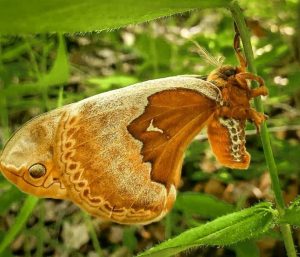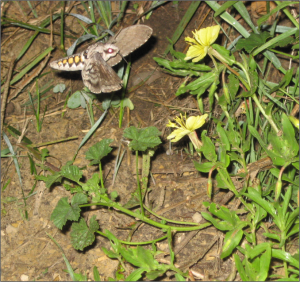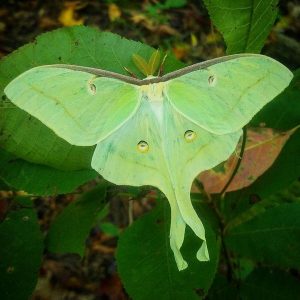The Importance of Moths
By Deanna Deterding, M.S., SIUE

Did you know that moths outnumber butterflies 14:1 globally? In Illinois there are roughly 2000 members of the insect Order Lepidoptera (moths and butterflies). Of the 2000 species of Lepidoptera over 90% of these are moths and less than 10% are butterflies. Despite how numerous moths are, conversations about pollination and pollination studies tend to focus on bees and butterflies. Part of this may be because bees and butterflies are active during the day (diurnal) when most people are too, whereas most moths (but not all) are active at night (nocturnal).

Moths are incredibly diverse, filling several roles and niches in the natural community. Nighttime pollination is one of many ecosystem niches filled by moths. Adult moths are pollinators of many plant groups. Hawkmoths in particular have been found to be big contributors of pollination for some evening primrose (Oenothera spp.). Furthermore, the Illinois native and endangered prairie fringed orchid (Platathera leucophaea) is only known to be pollinated by certain hawkmoths species.
Pollination is not the only ecosystem service that moths provide! The caterpillar or larvae stage are dependent on their host plants for a food resource and help break down plant material and in return nutrients to the soil. Moths at all stages of life are prey to numerous species of birds, bats and other insects which rely on moths for food. Additionally, moths are sensitive to changes in their environment, and because of this, monitoring moth diversity and abundance can be used to assess the quality of their habitat. In Illinois, moth diversity has been in decline especially in prairies and wetlands. The best way that we can protect them, and many other animals is to protect their habitat!

Many moths are pollinators, unlike luna moths (Actias luna). Adult luna moths do not feed from plants, rather relying on the fat storages from their life as a larva. May and June are the time to look for luna moths in Southern Illinois.
CLIFFTOP, a local nonprofit organization, is focused on preserving and protecting area blufflands.
A version of this article appeared in the June 22, 2022 edition of the Republic-Times.
©2022 all content rights reserved Clifftop NFP
Comments are currently closed.
